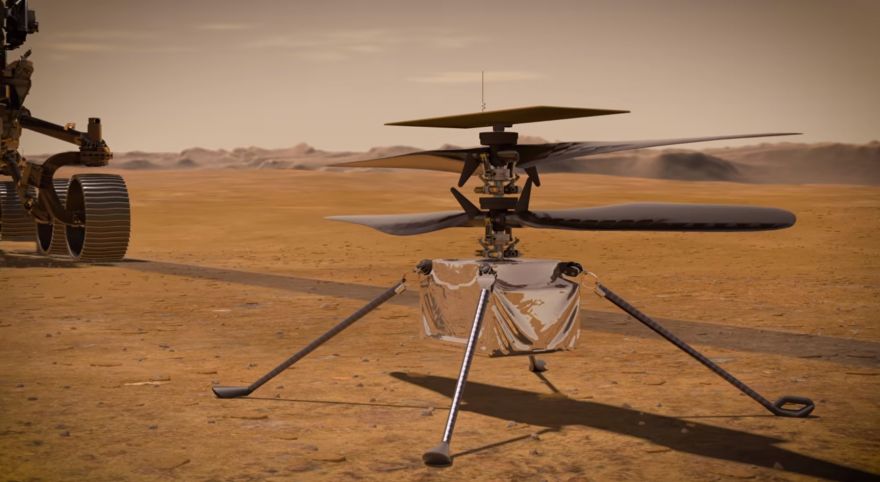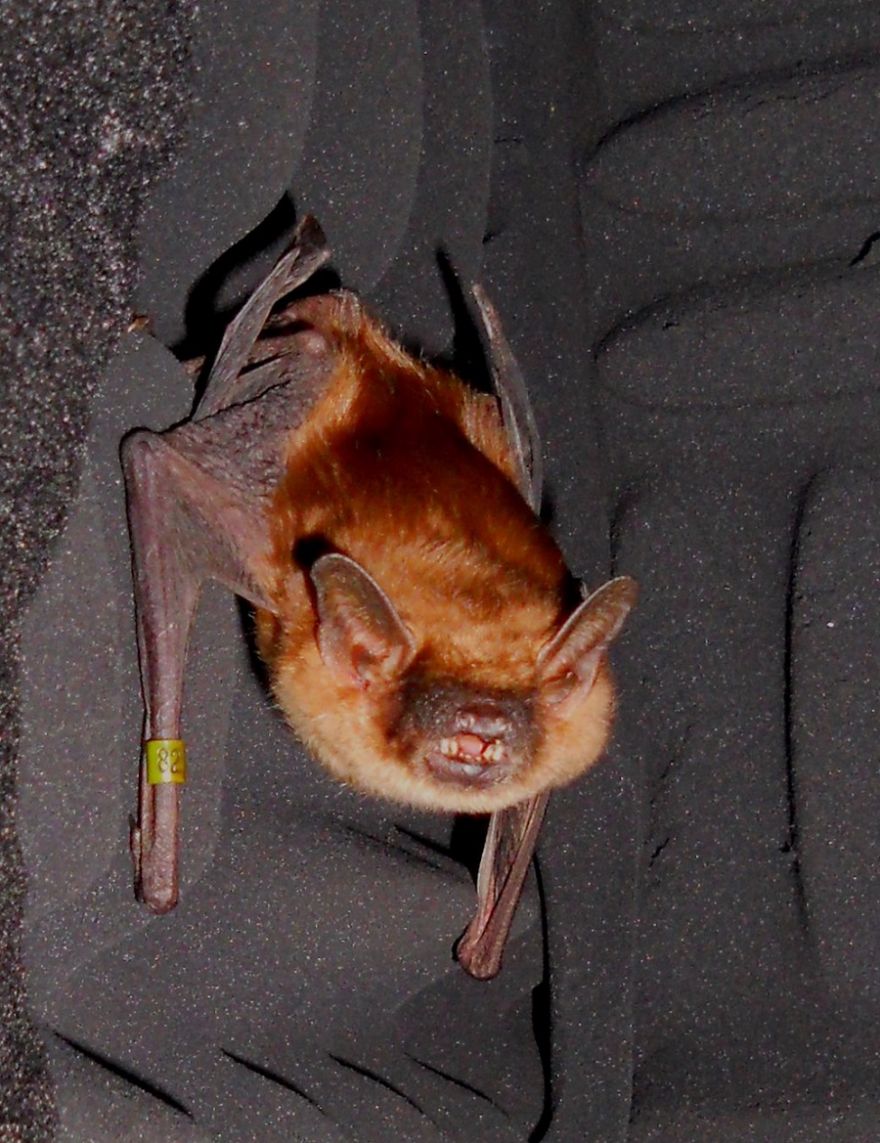Neatorama |
- NASA’s Mars Helicopter Ingenuity To Fly Soon
- How Bats Distinguish Echoes
- A Guide To Making Ice Cream At Home
- Ennio Morricone Passes Away At 91
- Man Attaches Lawn Mower To His SUV
- A New Way To Calculate Dog Age
- Fan Bra
- An Honest Trailer for the Indiana Jones Trilogy
- The Lost Art of Growing Blueberries With Fire
- Recommended Educational Documentaries For Kids And Teens
- This Dog's Concerned Face Is NOT An Illusion
- The Device That Preceded The Cinema And Virtual Reality
- This Jailhouse Got Sold Accidentally
- The Mayan City of Tikal And Why It Was Abandoned
- The Glassmaker Who Paved The Way For Astrophysics
| NASA’s Mars Helicopter Ingenuity To Fly Soon Posted: 08 Jul 2020 01:10 AM PDT
Decades ago, America first dreamed of sending humans to other places in space. German-American rocket engineer Wernher von Braun was one man who had that dream. He pictured sending dozens of people to Mars via a huge spacecraft. He envisioned a winged craft soaring through the Red Planet's atmosphere, landing gently on the rust-colored surface. And though earthlings quickly learned that traveling to another planet isn't so easy, the fantasy of flying on Mars never died. It could be said that von Braun was very dedicated, if not obsessed, with his dream of sending many people to space. With help from his friend Willy Ley, von Braun was able to publish his concepts, with many of them becoming a reality throughout the years. Clearly, he was a visionary, and it seems that his dream is one step closer towards reality. On July 22, NASA plans to launch its Mars Perseverance rover. But there's also a robotic hitchhiker onboard; this small, solar-powered helicopter, named Ingenuity, is on a mission totally independent from the rover. While Perseverance searches for signs of alien life, Ingenuity will prove it's possible to fly in Mars' thin atmosphere. The data it gathers will help engineers build even larger helicopter drones for the Red Planet. And if it works, the long-term impact could be a game changer for Mars exploration. Learn more about this solar-powered helicopter over at Discover Magazine. (Image Credit: NASA Jet Propulsion Laboratory/ YouTube) |
| Posted: 08 Jul 2020 01:10 AM PDT
With their very sharp ears, bats can handle themselves pretty well and look for food even in the pitch-black darkness. By clearly distinguishing one echo from another, they are able to navigate through the night. But how do they do it? Scientists from Brown University may have figured it out. They refer to it as frequency hopping, which involves focusing on the echoes' lowest frequencies. And it has potential, neuroscientist James Simmons and colleagues suggest in a paper in the journal Proceedings of the National Academy of Sciences. "By incorporating this feature into an existing auditory model of FM biosonar, the model can reject echoes that lack the lowest frequencies in the most recent broadcast, thus suppressing echoes of an earlier broadcast that has slightly higher low-end frequencies," they write. Bats locate objects by emitting ultrasonic sounds called broadcasts, which contain frequencies ranging from 25 kHz to 110 kHz, and listening to the returning echoes. Occasionally, an initial broadcast elicits a long-delay echo reflected from a distant object, and a closely successive broadcast triggers a short-delay echo from a nearby object. They reach the bat's ears at about the same time, but the bat deals with the potential ambiguity in matching the echo to the correct broadcast. It's just amazing how bats can do this quickly. More details about this study over at Cosmos Magazine. (Image Credit: BatLab/ Cosmos Magazine) |
| A Guide To Making Ice Cream At Home Posted: 08 Jul 2020 01:10 AM PDT
In the late 1960s, young Alex Heard was at a family reunion, and there he would meet someone cranking up a strange machine. It was an ice cream maker, "the kind that looks like a big wooden bucket with a metal handle on top." At the reunion, I was fascinated by this gizmo, and I soon pitched in and did a long session of cranking, which was hard work. I didn't mind. It was fun, and I wanted to share in the cheers that I figured would rain down when we were done. Which is exactly what happened. The ice cream we produced was a bit soupy but delicious. Somebody suggested I put syrupy sliced yellow peaches on mine. I did. That made it even better. This might have been what inspired him to make his own ice cream at home, and, decades later, he still does it, but now with his own ice cream maker at home. Now, he has written a simple guide on how to make delicious ice cream at your own home. Check out his guide over at Outside Online. Have you made your own ice cream before? (Image Credit: Counselling/ Pixabay) |
| Ennio Morricone Passes Away At 91 Posted: 08 Jul 2020 01:09 AM PDT
He was known for his phenomenal music in The Good, The Bad, and The Ugly, as well as his other magnificent musical works on hundreds of other films and television productions. His name: Ennio Morricone. While he may have passed away, his legacy — his compositions — will continue to live on. Morricone died Monday in Rome at the age of 91. The Italian cultural ministry confirmed his death in a statement that called him "a musician of refined skill who with his melodies has been able to excite and make the whole world dream." When Morricone wrote a score for a Western, he used sneaky tricks to make those evocative sounds, like whistles, animal calls, creaks, gunshots and groans… Know more about Morricone and his life over at NPR. (Image Credit: Georges Biard/ Wikimedia Commons) |
| Man Attaches Lawn Mower To His SUV Posted: 08 Jul 2020 01:09 AM PDT
"I choose a lazy person to do a hard job, because a lazy person will find an easy way to do it," said Bill Gates once. That realization couldn't have been more true: lazy people will always find an easy way, whether in the workplace, their own homes and lawns. Check out this video of a man who probably got so tired of mowing his lawn that he decided to attach it on his SUV. I don't know if I should be happy or angry about this. But one thing's for sure: whoever's driving that car is indeed innovative. What are your thoughts about this one? (Image Credit: ViralHog/ YouTube)
|
| A New Way To Calculate Dog Age Posted: 07 Jul 2020 11:12 PM PDT
Multiplying a dog's age by 7 is a common method used to know how old a dog is based on human years. This, however, is an inaccurate method. Now, scientists have developed a new molecular tool, which, according to them, can tell a more accurate picture of a dog's age in human years. The tool, which they describe as an "epigenetic clock", drills into the rate of molecular changes in the DNA. The work was carried out by scientists at the University of California San Diego (UCSD) School of Medicine, who worked with genome experts to examine blood samples taken from 105 Labrador retrievers, ranging in age from a few weeks to 16 years old. [...] Epigenetics has emerged as a valuable tool for tracking the physiological age of humans, and the UCSD team set out to explore its potential in doing the same for canines. The analysis of the 105 Labradors enabled them to tease out patterns of methylation change that revealed a truer picture of their [physiological] age. [...] One limitation of the research, as the scientists note, is that it was focused on one breed of dog, something they plan to expand on through further work. They hope that the formula could become a valuable tool for veterinarians as a way of offering improved diagnostics for dogs and treatment plans. More details about this study over at New Atlas. (Image Credit: Chiemsee2016/ Pixabay) |
| Posted: 07 Jul 2020 07:36 PM PDT Need to stay cool this summer? I'm a fan of Nicole McLaughlin's product idea. Her functional fan bra is adjustable so that you can tilt the rotors directly at your face. If you're not in a hot climate, then you might prefer McLaughlin's croissant bra, juicebox bra, cleaning wipes bra, or her sandwich bra. |
| An Honest Trailer for the Indiana Jones Trilogy Posted: 07 Jul 2020 07:36 PM PDT
|
| The Lost Art of Growing Blueberries With Fire Posted: 07 Jul 2020 04:39 PM PDT
Who knew that you burned blueberry bushes in the spring to spur yield? The process was developed by the Passamaquoddy people of Maine long before Europeans arrived, and is still in use, although most commercial growers have mechanized the process. Not Nicolas Lindholm of Blue Hill Berry Company. He is among the few growers who burn the fields by hand, using a crew of volunteers, to produce organic blueberries.
Read about the difficult but rewarding process of growing blueberries in the traditional manner at Atlas Obscura. |
| Recommended Educational Documentaries For Kids And Teens Posted: 07 Jul 2020 04:39 PM PDT
For those who are planning to homeschool their kids, CNN has listed 9 educational documentaries for different subject areas. However, these are also good considerations for adults! Their list includes Spellbound, He Named Me Malala, Jane, Apollo 11, Underwater Dreams, Chasing Coral, Elephant, Babies, and Elián.
What are your favorite educational movies and documentaries? Image Credit: Evert F. Baumgardner via Wikimedia Commons |
| This Dog's Concerned Face Is NOT An Illusion Posted: 07 Jul 2020 04:39 PM PDT We've read about a cat that has a sad face as an illusion. Now, here's a dog with RCF (Resting Concerned Face)... and it's not an illusion! Part Pekingese, Dachshund, and Chihuahua, Old Man Bacon (complete with a white beard) has an Instagram account that is chock-full of him looking concerned and confused—like he's just come to the realization that something has gone horribly awry. (Or, like the Jean Ralphio meme, he's just realized that he's taken on too much responsibility.) If you're a chronic over-thinker or a worry wart, Bacon is bound to be your spirit animal. Don't worry, though! He's a happy dog despite looking worried all the time. Here's a proof: Image Credit: thebaconator via Instagram |
| The Device That Preceded The Cinema And Virtual Reality Posted: 07 Jul 2020 01:12 PM PDT
February 20, 1826. People were inside a small theatre in the big city of London, waiting with their eyes open in the pitch black darkness of the room. Suddenly, there was light shining across the room — it was a replica of our Sun. When the viewers' eyes finally adjusted from the sudden change in lighting, they realized that they are no longer in the theatre, but inside the Rosslyn Chapel in rural Scotland. It was magical, indeed. The viewers were inside the work of a French inventor, Louis Daguerre. The diorama was one of his many inventions, a multimedia spectacle that took the mid-nineteenth century by storm. The first diorama was constructed in 1822, behind the Place du Château d'Eau (now the Place de la République). Daguerre's studio was located in the 10th arrondissement, in Paris, rue Faubourg du Temple; the area was shabby and underdeveloped, consisting of old army barracks and a smattering of theaters. Once customers entered the theater, however, they soon forgot their dilapidated surroundings. They were transported, as it were virtually, to places and moments in history: the Black Forest; the Inauguration of the Temple of Solomon; the Great Fire of Edinburgh. The modern cinema, as well as technological advancements like virtual reality, can trace their roots back to this amazing invention. Learn more about Daguerre's diorama over at JSTOR Daily. (Image Credit: Wikimedia Commons) |
| This Jailhouse Got Sold Accidentally Posted: 07 Jul 2020 01:12 PM PDT
It was 1943, and the city of Harvard in Clay County, Nebraska, decided to dispose of unused plots of land by selling them at $1.50 apiece. Upon seeing this great offer, a 16-year-old man named Robert Pinckney, who was the son of a local physician, decided that he wanted some for himself so that he can build victory gardens in summer. But upon seeing the list of plots on sale, Robert saw that the plot of land in which the jailhouse stands was also one of the properties on sale. As any good and responsible citizen would have done, Robert informed the city council about their mistake. But they only laughed at him. Robert decided that the best revenge would be to buy the plot, which he did. And so the sale was made and the deed papers signed, and still the city refused to admit their mistake. They pretended as if nothing happened, and continued to house criminals in the jail. Once Robert put a lock on the jail, but the city officials smashed it and threw him off the premises. So Robert hired a lawyer and sued the city for owned rent… The jailhouse would then get a wide media coverage, making the city of Harvard famous. The jailhouse would also contribute much to the war effort, but how? Find out the rest of the story over at Amusing Planet. (Image Credit: Jimmy Emerson/ Flickr/ Amusing Planet) |
| The Mayan City of Tikal And Why It Was Abandoned Posted: 07 Jul 2020 01:12 PM PDT
The Mayan city of Tikal was a thriving city that has prospered and expanded for hundreds of years. But in the ninth century A.D, something happened in the city that made its citizens abandon the place, but what was it? It turns out that mercury and toxic algae are what drove the people out of the city, as these poisoned their drinking water, and since they were already struggling to survive the dry season, this made their situation worse. Per the study, published last month in the journal Scientific Reports, the Maya sought to collect as much water as possible during the region's rainy season, developing huge, paved plazas that were sloped to send water sluicing into the reservoirs for storage. As the researchers argue, this system inadvertently contributed to the city's undoing. To assess the factors at play in Tikal's demise, the team took samples of sediments at the bottom of four of Tikal's reservoirs. Chemical and biological analyses of layers dated to the mid-800s revealed the grim history of the lakes' contents: As Ruth Schuster reports for Haaretz, two of the largest reservoirs were not only dangerously polluted with the heavy metal mercury, but also carried traces of enormous toxic algal blooms. [...] "The water would have looked nasty," says co-author Kenneth Tankersley, an anthropologist at the University of Cincinnati, in the statement. "It would have tasted nasty. Nobody would have wanted to drink that water." More details about this sad story over at Smithsonian Magazine. (Image Credit: Raymond Ostertag/ Wikimedia Commons) |
| The Glassmaker Who Paved The Way For Astrophysics Posted: 07 Jul 2020 01:12 PM PDT
How far is our Sun from our planet? How far is the Moon? How far are the stars that we see in the night sky? While some of these questions are already answered by today's science, hundreds of years ago people did not know how to answer these questions, but they created ways to attempt to answer them. Ingenious efforts to measure distances to them began in earnest in the 3rd and 4th centuries B.C., and astronomers and astrophysicists today, with high-powered telescopes and computers, still ponder the universe and attempt to tease out answers to millennia-old questions. Two hundred years ago, a man named Joseph von Fraunhofer made one of the most important discoveries that would help astrophysicists today in calculating the distances of celestial objects. He had found "the hidden code in starlight." Learn more about Fraunhofer's life, as well as his discovery over at Nautilus. (Image Credit: Hans/ Pixabay) |
| You are subscribed to email updates from Neatorama. To stop receiving these emails, you may unsubscribe now. | Email delivery powered by Google |
| Google, 1600 Amphitheatre Parkway, Mountain View, CA 94043, United States | |














No comments:
Post a Comment
Keep a civil tongue.